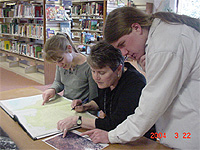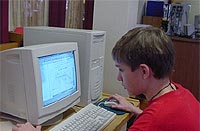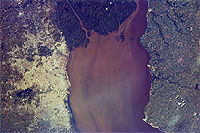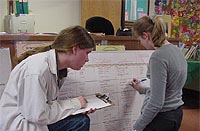Features
Exploring Earth with EarthKAM
04.08.04
| Who are NASA's Earth Explorers? The elementary school student wondering how El Niño will affect tomorrow's weather. The scientist studying connections between ozone and climate change. And the farmer using satellite pictures to keep track of crops. All of these people are Earth Explorers -- they are all curious about the Earth system. This monthly series will introduce you to NASA Earth Explorers, young and old, with many backgrounds and interests. |
You don't have to be an astronaut to snap a photograph of Earth from space. You don't even have to work for NASA.

|
Then believe Alice Shaw and Harry Swan. These eighth-graders are on the ISS (International Space Station) EarthKAM team at Brunswick Junior High School in Brunswick, Maine. EarthKAM is a digital camera mounted in a window onboard the ISS that takes pictures of Earth. Students control the camera, decide what pictures it takes, and then use the pictures to conduct scientific investigations.
"EarthKAM is different from [regular] school subjects because it combines science, math and geography -- and applies it," said Shaw, one of more than 30 students on the Brunswick team.
Science teacher Diane Bowen is in her sixth year running the after-school EarthKAM program at Brunswick. "The reason I love the project so much is because it affords the students the opportunity to do real science," Bowen said. "It's authentic science, not just reading outdated books and doing worksheets."

|
Photograph requests are reviewed by a team of students at the University of California, San Diego (UCSD), before being passed on to the Johnson Space Center in Houston, Texas, where they are uplinked to the ISS. Finally, as EarthKAM passes over the desired area, the picture is taken and transmitted to the Jet Propulsion Laboratory in Pasadena, California, before being posted on the Internet.
Bowen's students develop presentations, often in PowerPoint, based on the photographs they request as well as those already in the EarthKAM database. The students analyze the pictures and research aspects they find interesting or curious.

|
Although EarthKAM is geared toward middle schoolers, former Brunswick Junior High students Evan Pease, a ninth-grader, and Ben Hauptman, an 11th-grader, have continued their participation even after graduating to nearby Brunswick High School. One of Pease's recent projects focused on the history of the High Aswan Dam in Egypt. Currently, Pease is working with two other students to investigate the geology of Australia.
"It's always interesting to take a picture of something that you are learning about in school," Pease said. "Sometimes when I'm in school and my class is talking about some geographical feature, I think, 'I wonder what that looks like from space?'"

|
Hauptman and other team members are passing the lessons they learn on to others -- younger, older, and in other parts of the world. On Space Day, for example, they teach elementary school children about space and space travel. They also conduct workshops on EarthKAM for teachers.
And in preparation for EarthKAM's next photo-taking mission scheduled for May, the veteran Brunswick team is taking a newcomer under its wing. Bowen has forged a partnership with a newly formed EarthKAM team from Alberta, Canada. The two teams recently exchanged PowerPoint presentations about where they live, and then met each other by videoconference. During the May mission, Brunswick students will answer questions from their counterparts north of the border via an Internet "help desk."
EarthKAM offers opportunities to older students as well. UCSD undergraduates play a critical role in operating and maintaining the program, including the development of software, running the Web site, working with schools, and adding educational value to images. UCSD students can volunteer, intern, earn academic credit, and receive scholarships for their work with the program.
Photographs are archived and available to anyone through the EarthKAM Web site, which contains a host of resources for educators and students, including guides to requesting, interpreting and investigating images; information on the ISS and the Space Shuttle; weather links; and games and quizzes.
View site:
http://www.earthkam.ucsd.edu
Middle school educators can register for ISS EarthKAM at:
http://datasystem.earthkam.ucsd.edu/ekReg/ekRegistration.shtml
See previous Earth Explorers articles:
+ View site
Related Resources
Where is the International Space Station?
http://science.nasa.gov/temp/StationLoc.html
Earth Images BINGO
http://www.earthkam.ucsd.edu/public/educators/pdf/BINGOEarthImages.pdf
Earth as Art
http://landsat.gsfc.nasa.gov/earthasart